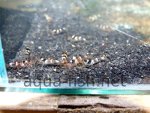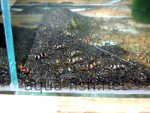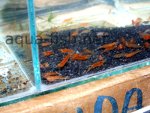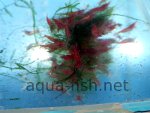Complete Guide to Caring, Feeding, and Breeding Amano Shrimp (Caridina Japonica)
Quick Links - Answers
Brief Description
This page is devoted to raising Amano shrimp in fish tanks. Our forum, located under the article, contains useful information and experiences. We also encourage you to submit your experiences with Caridina japonica. Looking to buy Amano shrimp? Simply follow this link to find suppliers!
Aquarium Life
Amano shrimp are highly adaptable and can live in a wide range of aquariums, but they thrive best in tanks with neutral to slightly acidic pH (6.5-7.5). They are hardy and can tolerate water temperatures ranging from 71°F to 82°F (22°C – 28°C), though an optimal temperature of around 75°F (24°C) is recommended. The water should not be too soft; sufficient calcium is necessary for their shell development, which is critical during molting.
These shrimp are naturally shy and will spend a lot of time hiding if kept alone. Therefore, it’s best to house them in groups of five or more. They live primarily at the bottom of the tank, so it’s more important to consider the available floor space rather than the water volume. While they can live peacefully in community tanks, avoid aggressive tank mates that may see them as food.
During molting, Amano shrimp shed their old shells to grow new ones. This is a vulnerable time, so providing plenty of hiding spots such as plants, caves, or driftwood is essential. After molting, they are soft and may be injured by aggressive fish. Additionally, remove them from the tank during any medication treatments, as they are sensitive to chemicals, particularly those that reduce oxygen levels.
Expert Tip: Maintain stable water parameters to reduce stress and prevent frequent molting, which can weaken shrimp over time.
Feeding Amano Shrimp
Amano shrimp are known for their algae-eating habits, but they are not a complete solution for algae control. They prefer certain types of algae, like hair algae, but they may ignore others such as green spot algae. The best way to keep algae under control is to maintain proper tank conditions, including appropriate lighting, filtration, and balanced stocking of plants and fish.
In addition to algae, Amano shrimp will scavenge for leftover fish food, organic matter, and even dead fish. However, to ensure they receive the proper nutrition, it’s a good idea to feed them regularly with high-quality shrimp pellets, blanched vegetables like spinach or zucchini, and Spirulina-based foods. While they don’t eat plants, they may consume decaying plant matter, helping keep the tank clean.
Feeding Schedule: Offer supplemental food once or twice a week in addition to their scavenging habits. Ensure not to overfeed to maintain water quality.
Common Mistake: Overfeeding can lead to water pollution and health issues for both shrimp and fish. Always remove uneaten food promptly.
Breeding Amano Shrimp
Breeding Amano shrimp is considered moderately difficult due to the specific needs of the larvae. The adults show clear sexual dimorphism: females are larger, reaching 2-2.4 inches (5-6 cm), while males only grow up to 1.2 inches (3 cm). When females are ready to breed, they release pheromones, which trigger males to swim energetically around the tank.
The challenge in breeding comes after the eggs are laid. Amano shrimp larvae require brackish water to survive. Here’s a step-by-step guide to breeding them:
- Breeding Tank Setup: Set up a separate 20-liter (5.28 US gallons) tank with no substrate and a sponge filter for gentle water movement. Fill it with brackish water (salinity of around 17-20 PPT).
- Larval Feeding: Larvae feed exclusively on phytoplankton, which can be cultured in a separate tank exposed to sunlight. Feed them multiple times daily to ensure steady growth.
- Transitioning to Freshwater: After around six weeks, the larvae undergo metamorphosis into juvenile shrimp. At this point, they can be acclimated back to freshwater and introduced to the main tank.
Breeding Challenges:
- Brackish Water Maintenance: Maintaining the correct salinity is crucial. Use a refractometer to monitor salinity levels accurately.
- Phytoplankton Supply: Ensure a consistent supply of phytoplankton, which may require setting up a dedicated phytoplankton culture.
- Larval Care: Protect larvae from being sucked into filters or eaten by fish by using fine mesh filters and providing ample hiding spots.
Expert Tip: Regularly monitor water parameters in the breeding tank to ensure optimal conditions for larval development. Stable conditions lead to higher survival rates of larvae.
Health & Diseases
Maintaining the health of your Amano shrimp is essential for their longevity and breeding success. Here are some common health issues and how to prevent them:
Common Diseases:
- Molting Problems: Poor water quality or inadequate calcium levels can lead to incomplete molts. Ensure regular water changes and maintain proper water hardness.
- Bacterial Infections: Overcrowding and poor filtration can cause bacterial growth, leading to infections. Keep the tank clean and avoid overstocking.
- Parasites: Shrimp can be susceptible to parasites like shrimp mites. Quarantine new shrimp before adding them to the main tank.
Prevention Tips:
- Maintain high water quality with regular water changes and proper filtration.
- Ensure a balanced diet with sufficient calcium and other essential minerals.
- Provide ample hiding spots to reduce stress and prevent aggression from tank mates.
Expert Tip: Regularly test your water parameters to catch any deviations early and address them before they become serious issues.
Pros and Cons of Keeping Amano Shrimp
Pros
- Excellent Algae Eaters: They are particularly effective at controlling hair algae.
- Peaceful Tank Mates: Amano shrimp get along well with most community fish and do not harm plants.
- Low Maintenance: Hardy and adaptable, they are suitable for beginners.
- Nutrient Recycling: They help keep the tank clean by consuming leftover food and decaying matter.
Cons
- Breeding Challenges: Their larvae need brackish water and phytoplankton to develop properly.
- Molting Vulnerability: They are delicate during molting and require a stress-free environment to recover.
- Water Quality Risks: Uneaten shrimp can decay quickly, potentially polluting the water. Be careful not to overfeed.
Overall, the benefits of keeping Amano shrimp far outweigh the drawbacks. They’re an excellent choice for those looking to breed shrimp or provide additional nutrition for young fish while maintaining a clean and healthy aquarium environment.
Where to Buy Amano Shrimp Online
Here are some online suppliers where you can purchase Amano shrimp. Please note that online shops may cease to exist or change over time, so we also recommend using search engines for updated options. The link below will take you to DuckDuckGo's shopping search results for Amano shrimp.
Expert Tip: Always purchase shrimp from reputable suppliers to ensure you receive healthy and disease-free specimens.
Frequently Asked Questions (FAQ)
- Can Amano shrimp be kept with all types of fish? Yes, as long as the fish are not aggressive and do not view the shrimp as food.
- How long do Amano shrimp live? With proper care, Amano shrimp can live up to 2 years in a well-maintained aquarium.
- Do Amano shrimp eat live plants? Generally, no. They prefer decaying plant matter but will not harm healthy, living plants.
- How often should I feed my Amano shrimp? Supplement their diet once or twice a week with high-quality shrimp pellets or blanched vegetables.
Conclusion
Keeping Amano shrimp is a rewarding experience that enhances the cleanliness and balance of your aquarium. They are excellent algae eaters, peaceful tank mates, and relatively easy to care for. While breeding them presents some challenges, the benefits of having a thriving shrimp population far outweigh the difficulties. By following this comprehensive guide, you can ensure your Amano shrimp remain healthy, active, and contribute positively to your aquatic ecosystem.
Don't forget to join our forum to share your experiences and learn from other aquarists! Your insights can help others successfully raise and breed Amano shrimp.





